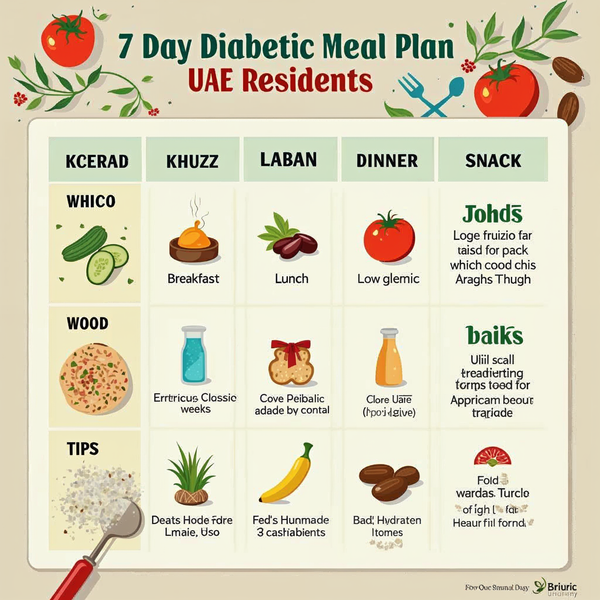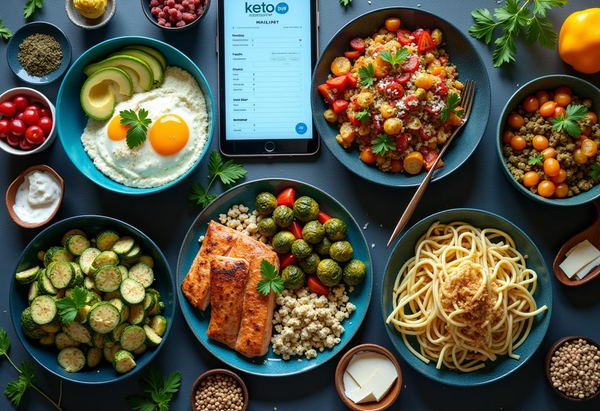Diabetic Meal Plan in UAE: 7-Day Guide with Local Foods & Blood Sugar Tips
by JUSTINE YOLANDA

Living with diabetes in the UAE brings unique challenges and opportunities when it comes to managing your blood sugar through diet. With rising diabetes rates across the region, especially in fast-paced urban areas like Dubai and Abu Dhabi, many residents are actively seeking sustainable, culturally relevant meal plans that actually work. Whether you've just been diagnosed with type 2 diabetes or are simply trying to stabilize your blood sugar levels, what you eat daily matters more than ever.
But here's the truth: most diabetes meal plans online are designed with Western diets in mind. They include foods you rarely find in your local Carrefour or Lulu and overlook the UAE’s traditional ingredients and lifestyle habits. That’s why we’ve created this UAE-specific 7-day diabetic meal plan, packed with local produce, regionally available proteins, and practical tips for blood sugar control in a desert climate.
Why a UAE-Specific Meal Plan Matters
Diabetes management is not one-size-fits-all and that’s especially true in the UAE, where local eating habits, cultural traditions, and environmental factors shape what people eat and how their bodies respond to food.
For starters, the traditional Emirati and South Asian-influenced diets often include high-carb staples like white rice, parathas, khubz (Arabic bread), and sweetened drinks like karak chai or laban. While these foods are part of the culture and daily life, they can quickly lead to blood sugar spikes if not balanced properly with protein, fiber, and healthy fats. A UAE-specific meal plan recognizes these realities and offers realistic swaps and portion strategies without forcing residents to completely abandon their culinary roots.
Another critical consideration is the UAE’s extreme climate. With long, hot summers and high humidity, staying hydrated becomes more than just a health tip. It's a necessity. Dehydration can worsen blood sugar control, especially during fasting periods like Ramadan. A diabetic meal plan tailored to this region includes hydration strategies, like incorporating more water-rich foods (cucumbers, tomatoes, melons) and keeping electrolyte levels stable.
Additionally, eating schedules vary across cultures here. Late-night dinners, weekend brunches, or communal family meals can disrupt regular blood sugar rhythms. A meal plan that accounts for these patterns while still supporting stable glucose levels is far more effective than rigid Western-style plans.
Simply put, a diabetes-friendly diet that works in New York or London won’t necessarily work in Sharjah or Abu Dhabi. A UAE-specific approach ensures meal plans are culturally acceptable, locally accessible, and more sustainable in the long term.
Blood Sugar-Friendly Foods in UAE
Living in the UAE means you have access to a rich variety of fresh, local foods that can help stabilize blood sugar levels when chosen and prepared wisely. Here’s a breakdown of diabetes-friendly options you can easily find in supermarkets like Carrefour, Lulu, Union Coop, or local markets.
Protein Sources
-
Grilled Chicken & Turkey – Lean and low-fat, ideal for meals without blood sugar spikes.
-
Fish – Hammour, salmon, and sardines are excellent for their omega-3s.
-
Eggs – Affordable and quick to prepare, great for any meal.
-
Lentils & Chickpeas – Packed with plant-based protein and fiber, excellent in stews or salads.
-
Greek Yogurt (Unsweetened) – A good breakfast or snack option with protein and probiotics.
Low-Glycemic Carbohydrates
-
Quinoa & Brown Rice – Lower GI than white rice and better for glucose control.
-
Whole Wheat Roti – A healthier swap for paratha or white naan.
-
Oats – Great for breakfast with nuts and berries.
Freekeh & Bulgur – Traditional grains with slow-digesting carbs.
Vegetables
-
Cucumber, Tomato, Lettuce – Hydrating and rich in fiber.
-
Okra (Bhindi), Eggplant, Cauliflower – Great in curries or roasted dishes.
-
Spinach, Kale, and Broccoli – High in nutrients and very low in carbs.
-
Zucchini & Bell Peppers – Ideal for stir-fries and grilled plates.
Fruits (in Moderation)
-
Berries (Frozen or Fresh) – Blueberries, strawberries, and raspberries are lower in sugar.
-
Apples, Pears, and Guavas – Fiber-rich and filling.
-
Melons (in small portions) – Good for hydration but monitor the quantity.
-
Pomegranate Seeds – Great for snacks or salad toppers.
Eating well with diabetes in the UAE is absolutely possible when you know what to pick and how to pair it.
7-Day Diabetic Meal Plan
Each day includes: breakfast, two snacks, lunch, and dinner all sourced from Basiligo’s Diabetic Meal Plan. Portions are calibrated to approximately 1,500 kcal/day with a balanced macro ratio: around 30–60g carbohydrates, 70–90g fat, and 110–140g protein.
Day 1
-
Breakfast: Basiligo diabetic breakfast (e.g., eggs with vegetables)
-
Snack 1: Yogurt-based snack (portion-controlled)
-
Lunch: Grilled protein with mixed vegetables and a low-GI grain
-
Snack 2: Small portion of nuts with fresh vegetable sticks
-
Dinner: Protein entrée (such as fish or poultry) with a side salad
Day 2
-
Breakfast: High-protein diabetic breakfast from Basiligo
-
Snack 1: Fresh vegetables with labneh or yogurt dip
-
Lunch: Balanced grain bowl (lentils/chickpeas, greens, and lean meat)
-
Snack 2: Unsweetened Greek yogurt with seeds
-
Dinner: Low-carb protein entrée with cooked low-GI vegetables
Day 3
-
Breakfast: Whole-grain porridge or an omelet-based meal
-
Snack 1: Nuts and cucumber slices
-
Lunch: Diabetic-friendly stew or curry with portioned grains
-
Snack 2: Herb-flavored yogurt snack
-
Dinner: Low-carb protein dish with cooked greens
Day 4
-
Breakfast: Savory diabetic breakfast plate
-
Snack 1: Fresh snack (nuts and raw vegetables)
-
Lunch: Mixed protein and salad bowl, low in carbohydrates
-
Snack 2: Greek yogurt with a small portion of fruit
-
Dinner: Grilled chicken or fish with vegetables
Day 5
-
Breakfast: Basiligo diabetic breakfast option
-
Snack 1: Vegetable medley snack
-
Lunch: Legume and lean protein salad
-
Snack 2: Yogurt with chia or flax seeds
-
Dinner: Low-carb protein dish with a side of vegetables
Day 6
-
Breakfast: Diabetic-friendly smoothie bowl or egg-based breakfast
-
Snack 1: Greek yogurt or laban
-
Lunch: Balanced diabetic lunch from Basiligo
-
Snack 2: Nut mix with fresh vegetables
-
Dinner: Steamed fish or lean protein with mixed greens
Day 7
-
Breakfast: Basiligo’s diabetic breakfast option
-
Snack 1: Unsweetened yogurt or labneh
-
Lunch: Grilled protein with roasted low-GI vegetables
-
Snack 2: Nuts and seeds
-
Dinner: Chicken or fish with vegetable side
Estimated Daily Totals
-
Calories: Approximately 1,500 kcal
-
Protein: 110–140g
-
Carbohydrates: 30–60g (low glycemic index focus)
-
Fat: 70–90g
-
Fiber: 25g or more per day
Customization & Hydration Tips
-
All meals can be rotated or swapped using Basiligo’s diabetic menu.
-
Stay hydrated by consuming at least 8–10 large glasses of water daily.
-
Basiligo’s plans are portion-controlled and customizable for dietary needs such as low sodium, gluten-free, or vegetarian options.
Shopping List for the Week
Planning ahead is key to staying consistent with a diabetic-friendly meal plan. Here's a simple shopping list to help you stock your kitchen for the week. All items are accessible in the UAE and tailored to low-GI, blood sugar-stabilizing meals.
Proteins
-
Skinless chicken breast or thighs
-
Fresh salmon or white fish (e.g., hammour)
-
Eggs
-
Low-fat Greek yogurt (unsweetened)
-
Labneh (unsweetened)
-
Lentils (red, green, or brown)
-
Canned chickpeas (low sodium)
-
Tofu or edamame
Whole Grains & Legumes
-
Quinoa
-
Brown rice
-
Whole wheat bread or wraps (check label for no added sugar)
-
Oats (steel-cut or rolled, unsweetened)
-
Whole grain pasta (optional, small portions)
Vegetables
-
Cucumber
-
Carrots
-
Zucchini
-
Spinach
-
Kale or local greens
-
Tomatoes
-
Bell peppers
-
Cauliflower
-
Broccoli
Fruits (Low-GI)
-
Apples
-
Berries (fresh or frozen)
-
Oranges
-
Pears
Healthy Fats
-
Avocados
-
Olive oil
-
Raw almonds, walnuts, chia seeds
Pantry Essentials
-
Spices: turmeric, cinnamon, cumin
-
Apple cider vinegar
-
Unsweetened nut butter (peanut or almond)
Tips for Dining Out & Snacking in the UAE
Navigating dining out in the UAE while managing diabetes doesn’t have to be stressful if you make informed choices.
Dining Out Smart:
Many UAE restaurants offer grilled options opt for grilled chicken, fish (like hammour), or mixed grills with salads. Ask for dressings and sauces on the side, and avoid deep-fried items like samosas or parathas. Choose whole wheat kuboos over white bread when available, and prioritize dishes with legumes, vegetables, and lean protein.
Snacking Wisely:
Convenience stores across the UAE stock raw nuts, unsweetened Greek yogurt, and small fruit portions go-to snacks when you’re on the move. Dates, though local and nutritious, are high in sugar limit to one or two with a handful of almonds to balance the glycemic load.
During Iftar or Ramadan:
Break your fast with water and a small portion of fruit or soup. Avoid sugary drinks like Vimto or rose syrup-based juices. Stick to grilled meats, vegetables, and lentil-based dishes. Avoid rice-heavy meals and desserts post-Iftar, as they can spike blood sugar rapidly.
With the right habits, you can enjoy UAE's diverse food culture without compromising your health.
Expert Tips for Blood Sugar Management
Managing blood sugar isn’t just about what you eat, it's about how and when you eat, move, and hydrate. Here are simple, effective strategies tailored to your lifestyle in the UAE:
1. Stick to Regular Meal Times
Eating every 4–5 hours helps prevent blood sugar spikes and crashes. Start your day with a balanced breakfast and avoid skipping meals, especially during busy work hours or fasting periods like Ramadan.
2. Move After You Eat
Physical activity improves insulin sensitivity. Just a 10–15 minute walk after meals, even around your building or community, can help lower your blood sugar more effectively than long, intense workouts done occasionally.
3. Prioritize Fiber-Rich Foods
Fiber slows digestion and blunts blood sugar spikes. Include whole grains like quinoa or brown basmati rice, and load up on non-starchy vegetables such as cucumbers, spinach, and okra. Aim for 25–30g of fiber per day.
4. Hydration Is Key
The UAE heat can lead to dehydration quickly, which may raise blood sugar levels. Drink at least 2–3 liters of water daily, and even more if you’re active or outdoors.
5. Balance Every Plate
Use the “half-veg, quarter-protein, quarter-carb” rule. Whether it’s a homemade meal or Basiligo’s diabetic-friendly plan, this structure keeps your blood sugar steady and cravings in check.
Implementing just a few of these tips consistently can lead to real improvements in your diabetes control over time.
Frequently Asked Questions About Diabetic Meal Plans
Q1. Can I eat dates if I have diabetes?
Yes, but in moderation. Dates are high in natural sugars, so limit yourself to 1–2 dates at a time and pair them with a protein or fat source like almonds or Greek yogurt to reduce blood sugar spikes.
Q2. What’s a good diabetic-friendly breakfast in the UAE?
Try a boiled egg with whole wheat toast and avocado, or Greek yogurt with chia seeds and berries. Basiligo also offers diabetic-friendly options like chia pudding and protein omelets.
Q3. What snacks can I eat that won’t spike my blood sugar?
Go for raw almonds, boiled eggs, veggie sticks with hummus, or unsweetened yogurt. Avoid processed snacks and sugary drinks, even traditional favorites like karak chai with sugar.
Q4. Is there a low glycemic index rice available in the UAE?
Yes. Basmati rice has a relatively lower GI compared to regular white rice. Choose brown basmati or try quinoa as a substitute for even better blood sugar control.
Q5. What’s the best time to eat meals for stable blood sugar?
Eat three balanced meals per day, spaced 4–5 hours apart. Include a small high-protein or fiber-rich snack in between if needed. Avoid skipping meals, especially during Ramadan.




